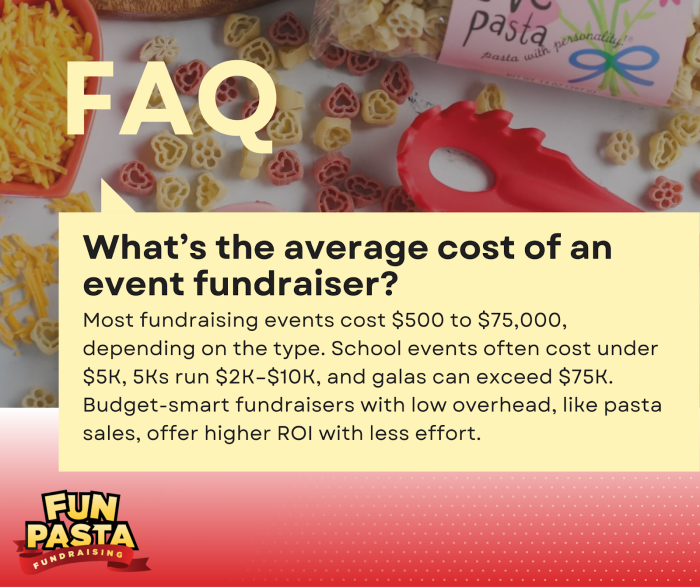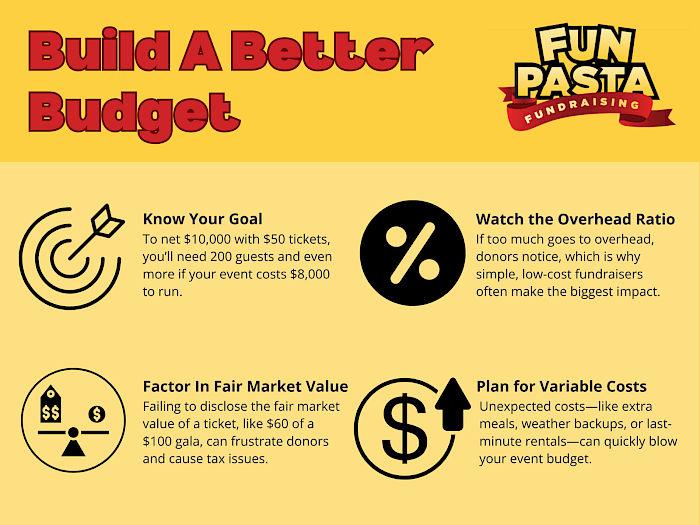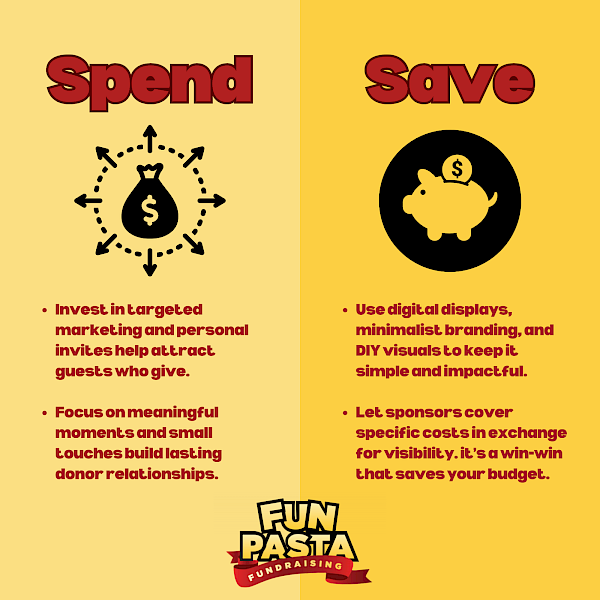Average Cost of Fundraising Events

Most fundraising events cost $500 to $75,000, depending on the type. School events often cost under $5K, 5Ks run $2K–$10K, and galas can exceed $75K. Budget-smart fundraisers with low overhead, like pasta sales, offer higher ROI with less effort.
Over the past 20 years, we’ve helped schools, teams, and nonprofits raise serious funds, while avoiding hidden costs, wasted effort, and the common pitfalls that derail so many fundraisers.
So if you’re planning your first event or weighing your options, we can help you understand what to expect, how to budget smart, and whether a product fundraiser might give you more bang for your buck.
Let’s take a closer look at the most common fundraising expenses, and why understanding where your dollars go can make or break your results.
The 8 Core Expense Categories You Must Account For

Planning a fundraising event means keeping your eye on the budget. No matter the scale, here are the eight categories that should be in every budget.
1. Venue Rental
Venue costs vary wildly depending on your city, event size, and desired ambiance. Here’s a ballpark:
- Small/local venues (like schools or churches): $250–$2,000
- Mid-size banquet halls or community centers: $2,000–$8,000
- Luxury or downtown event spaces: $10,000–$30,000+
Cost-saving tip: Many local businesses, schools, or even city buildings may donate space if you ask. Highlight the marketing exposure they’ll receive, this often works as a valuable in-kind sponsorship.
2. Food & Beverage
This can easily become your biggest expense.
- Average cost per plate: $20–$100+
- Cocktail hour snacks and drinks: $10–$25 per person
We’ve seen groups partner with local restaurants for donated meals in exchange for sponsorship placement, or even use food trucks, which offer variety and often come at a lower cost with built-in service.
3. Marketing & Promotion
You need guests and donors, and that means promotion.
- Email marketing tools (e.g., Mailchimp, Constant Contact)
- Social media ads and boosts: $200–$2,000 depending on reach
- Printed materials (flyers, signage, mailers): $100–$1,500+
Don’t forget the power of influencer outreach, even local community figures with 500 engaged followers can bring visibility.
4. Technology & Software
Modern fundraising events rely heavily on tech:
- Ticketing platforms (like Eventbrite): Free to 5% of ticket sales
- Auction tools (like OneCause or GiveSmart): $500–$3,000+
- CRM/Donor software integration: Optional, but helpful for long-term cultivation
For online-only or hybrid events, you’ll also need streaming tools, webcams, mics, and maybe a tech-savvy volunteer to run it all.
5. Permits, Insurance, and Legal Fees
If you’re serving food, alcohol, or hosting a public event, check your local laws:
- Special event permits: $50–$500
- Liquor licenses: $50–$1,000
- Event liability insurance: $200–$600+
Always better to be safe than sorry. These are easy to overlook but crucial for a compliant, stress-free event.
6. Entertainment
Entertainment can create a memorable experience, or break your budget.
- Local musicians or DJs: $250–$1,500
- National acts or speakers: $5,000–$20,000+
- Hidden fees: Always ask about rider clauses (special equipment, green rooms, transportation) that can balloon your total cost.
Pro tip: Don’t stretch your budget on talent if you’re tight. A creative playlist and good lighting often deliver the same guest satisfaction for a fraction of the cost.
7. Volunteer Coordination
Volunteers are amazing. But even they need organizing, training, and sometimes snacks or thank-you gifts.
- Volunteer software tools (e.g., SignUpGenius): Free to low-cost
- Volunteer appreciation items (T-shirts, gift cards): $100–$500
A tired volunteer can lose steam fast. Keep the experience smooth and rewarding for them too.
8. Miscellaneous Costs
Don’t forget the “extras” that sneak into your final bill:
- Raffle and auction supplies
- Decorations and lighting
- Printing name tags, table numbers
- Parking or transportation fees
These line items might seem small, but they add up, fast. Leave a buffer in your budget for the unexpected.
Real-Life Cost vs Return Examples
One of the most valuable things you can do before planning an event is learn from what other groups have done. Comparing time, effort, and net revenue helps you avoid burnout and focus your energy on what truly works for your community.
Pancake Breakfast
- Volunteers required: 20+
- Event time: 4 hours + prep and cleanup
- Effort level: High (hot kitchen, supplies, logistics)
- Gross revenue: ~$2,000
- Net revenue: ~$1,200
Ice Cream Social
- Volunteers required: 4–5
- Event time: 2 hours
- Effort level: Low (partnered with a local shop)
- Gross revenue: ~$325
- Net revenue: ~$325 (nearly no costs)
Smaller effort, a smaller return, but with the ability to repeat it multiple times a year without volunteer burnout.
How to Budget Smarter for Your Event

If you’re anything like the amazing groups we work with, you’re juggling fundraising, volunteer coordination, and daily life, all at once. That’s why it’s so important to plan intentionally before launching an event. The smartest fundraisers don’t start with the venue or menu, they start with the goal.
Start with Your Fundraising Goal and Work Backward
Build your budget to support your goal. If you want to net $10,000, and your ticket price is $50, that means you need 200 guests, after covering all expenses. But if your costs are $8,000, you’re going to need to raise a lot more to break even.
Factor In Fair Market Value (FMV) for Donor Receipts
Transparency matters. If someone pays $100 for a gala ticket, but the meal and entertainment are worth $60, the charitable deduction is only $40. That’s the Fair Market Value, and you need to state it clearly on receipts.
Ignoring this can not only frustrate donors but also cause problems with tax compliance.
Keep an Eye on Your Overhead Ratio
Every nonprofit has an overhead threshold, how much of each dollar goes to expenses vs your cause. Events with high costs can tilt this balance. Most experts suggest keeping event overhead under 25-30%, though it depends on your organization’s model.
If your expenses creep too high, donors may question how much of their gift is actually supporting the mission.
This is why low-cost, high-impact fundraisers, like selling our fun-shaped pasta, can really shine. No overhead, no fancy venue, and your supporters get something delicious in return.
Plan for Variable Costs
Things change. Here are some often-forgotten variable costs to budget for:
- Headcount increases (more guests = more meals, seats, and giveaways)
- Weather-related issues (outdoor tents, heaters, or backup indoor space)
- Last-minute rentals (A/V, chairs, signage)
- Shipping delays or supply shortages
What’s Worth the Money? Where to Spend vs Save

We know how easy it is to fall into the trap of “doing it all.” You want a beautiful venue, great food, dazzling décor, and an unforgettable experience. Smart spending isn’t about being cheap, it’s about making your dollars work harder.
Here’s where to spend and where to save:
Strategic Marketing
If people don’t know about your event, they won’t come. And if the right people don’t know, you won’t raise much. Your marketing strategy deserves a meaningful slice of your budget:
- Paid social ads (especially for auctions and galas)
- Boosted posts featuring donor stories or impact statements
- Email campaigns with early-bird offers and sponsor spotlights
Want to reach the right guests for your auction? Start by creating a targeted invite list of past donors, local business owners, and community champions, those with both capacity and connection to your mission.
Use VIP or “early access” auction previews as a motivator.
Great Donor Experiences
People remember how you made them feel, not how many balloons were on the table. So invest in:
- Personal touches (handwritten thank-you notes, name tags with meaningful labels like “STEM Hero”)
- Clear, emotional storytelling during the event
- Comfortable seating, good sound, and warm hospitality
These moments deepen relationships, which is what fundraising is all about.
Decorations and Swag
It’s tempting to go big on centerpieces, branded gifts, or keepsake bags. But unless it directly enhances the guest experience, it’s often money better spent elsewhere.
Instead, lean on:
- Digital displays instead of printed posters
- Minimalist décor with strong branding
- Volunteers to create DIY visuals (hello, themed pasta centerpieces!)
Cost-Sharing with Sponsors
Sponsors don’t always need a big invoice. Many are happy to cover one specific cost in exchange for visibility:
- A local bakery provides dessert (in exchange for logo placement)
- A small business donates printing services (gets thanked from the stage)
- A community partner sponsors the photo booth or auction software
Put The Fun in Fundraising
From first-time PTA committees to seasoned nonprofit teams, we’ve seen it all. And one truth stands out:
Big events don’t always mean big profits.
Between venue costs, volunteer burnout, and the time it takes to pull it off, many groups walk away wondering if the return was really worth the effort.
That’s why more and more leaders are choosing fundraisers that actually fundraise. Fun Pasta Fundraising is simple to run, built for profit, and works for schools, teams, and groups of every size.
If your goal is to raise money let us help you get there.
